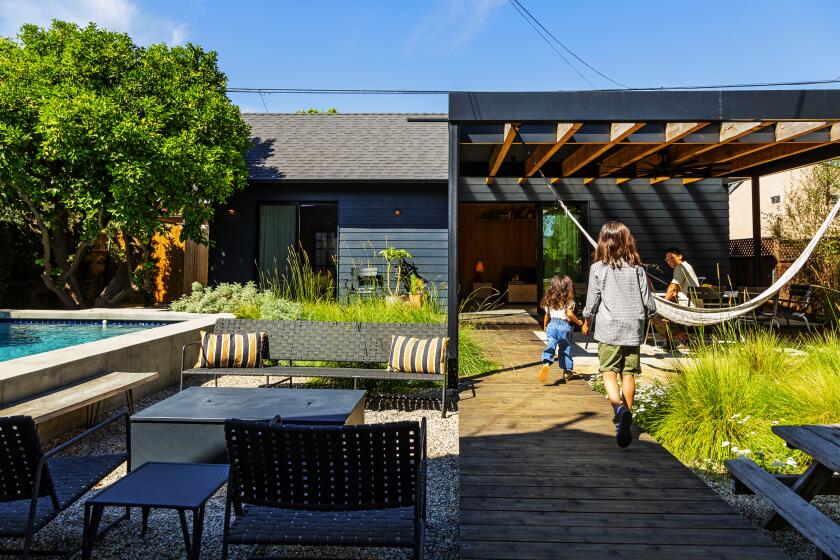Architects Seek to Be Growth-War Peacemakers
- Share via
Do architects owe their loyalty to the developers who hire them, or do they have to consider the greater needs of the community?
Mark Smith, president of the San Fernando Valley chapter of the American Institute of Architects, acknowledges that his colleagues are placed at the very center of the tensions between growth and anti-growth partisans.
“Developers are our clients, our bread and butter,” Smith said, “but we are also citizens crucially concerned with the quality of life. At our best we can act as mediators between homeowners who feel threatened by overdevelopment and the legitimate interests of the business community.”
Smith sees the architect’s role in this confrontation over growth as “explaining to both sides how good design can mitigate the impact of development. We can soften the rough edges, handle the awkwardness of size and scale between, say, a residential neighborhood and a commercial or civic complex.
Level of Debate
“Above all, I believe architects can raise the level of the often rancorous debate between pro- and anti-growth supporters by talking about design, not just development.”
As part of that mediation effort the SFV/AIA is involved in several Valley projects, including the development of guidelines for the proposed Van Nuys Civic Center Mall. The chapter’s stated interest in Van Nuys is to create a mixed-use retail and civic environment that “creates a truly humane setting in the heart of one of the Valley’s oldest communities.”
Local architects--there are 150 members in SFV/AIA-- split off from the 1,800-member parent Los Angeles chapter of the AIA in July, 1987, in the belief that the Valley has to concentrate on its own character and problems.
Some Valley architects felt they were “getting the short end of the stick” from the parent body. “The Los Angeles chapter treated us as delegates from a boring bedroom community,” one member said. “It got so uneasy that most Valley designers no longer bothered to go to chapter meetings.”
Local Control
Many SFV/AIA members feel the initiative to form their own chapter gave them more local control and the chance to concentrate on the Valley’s particular architectural and urban design challenges--Ventura Boulevard among them. Smith thinks that the Ventura Boulevard corridor that runs from Studio City to Woodland Hills will become Los Angeles’ next great urban center in 20 years, as a pivot for the fast-developing new suburbs to the north and west, such as the Antelope and Simi valleys.
Smith is the SFV/AIA’s first full-term president, succeeding the chapter’s first half-term president, Tom Layman, in January, 1988. His own Tarzana practice is a typical example of the small-sized Valley architect’s office. (Most members of SFV/AIA work in small offices employing fewer than three professionals.) Most of Smith’s projects include modest custom houses, schools and small commercial projects.
“One of our main frustrations as Valley architects is that most of the major projects are done by designers from the other side of the Santa Monica Mountains,” Smith said. “All the big buildings in the Warner Center, for instance, have been designed by large L.A. offices.”
Pulling Strings
Smith attributes this situation partly to the developers’ need to “pull strings downtown” by using well-connected architects, particularly when the projects are likely to be controversial.
“The commercial and civic power in L.A.--and therefore the architectural power--is concentrated around Bunker Hill and the Westside,” he said. “Out in the Valley most of us are too small or too peripheral to do battle with the big boys.”
But SFV/AIA hopes to remedy that situation with some ambitious plans to raise its profile in the Valley, including:
The opening of a “storefront” public office at 14951 Califa Street, in Van Nuys.
An architectural exhibit in the Fallbrook Shopping Mall, Canoga Park, on display Sept. 17 through Oct. 2.
Development of programs with the newly relocated Woodbury University School of Architecture in Burbank (Woodbury, which moved last year from Wilshire Boulevard in downtown Los Angeles, is the Valley’s only architecture school).
Participation in the international design competition for the proposed Arts Park L.A. in the Sepulveda Dam Basin on Victory Boulevard in Van Nuys.
Continuing class projects in Valley high schools similar to the Architecture Week event held last April at Olive Vista Junior High in Sylmar.
“The Olive Vista project got the students to design their own architectural fantasies,” Smith said. “The results were wonderfully inventive. In most cases this was the students’ first opportunity to think about architecture as the subject of their own creative effort.”
“The architecture project was the most important event of the semester for my children,” said Olive Vista art teacher Linda Ibach. “Many of them, especially the Hispanics, started out with no conception of what architecture is about. Mark Smith was so enthusiastic and patient that, by the end of the project, the seventh-grade students were truly excited by the possibilities he presented. It was an eye-opener for the kids.”
A Valley home tour scheduled for Sunday, Oct. 16. Six houses designed by gifted architects between 1959 and 1988 will be open to public view.
“The Home Tour will illustrate the extraordinary variety and vigor of the Valley’s architecture,” Smith said. “The vital individualism of our designers must be preserved as the Valley becomes more urban and more sophisticated.” (For further information on SFV/AIA projects call 818-881-5334.)
More to Read
The biggest entertainment stories
Get our big stories about Hollywood, film, television, music, arts, culture and more right in your inbox as soon as they publish.
You may occasionally receive promotional content from the Los Angeles Times.










